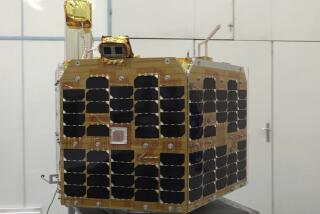Iran makes its first satellite launch
BEIRUT — Iran’s first successful satellite launch was greeted with official celebration in Tehran on Tuesday but with alarm in the West, where it stoked concerns about the Islamic Republic’s increased mastery of missile technology that could be used for military purposes.
Iran said the two-stage-rocket launch was meant for peaceful scientific purposes. But officials in Washington, long concerned about Iran’s nuclear program and regional ambitions, warned that its entry into the Space Age was an ominous development.
The satellite, called Omid, or “hope,” was apparently launched into orbit late Monday or early Tuesday using an Iranian-made Safir-2 carrier rocket, the official Islamic Republic News Agency reported Tuesday.
State TV showed fire erupting from the rocket as it rose against a pitch-black sky. The launch placed Iran among elite company, with only nine other nations and a European consortium having put satellites into orbit.
“Your children have sent Iran’s first domestic satellite into orbit,” Iranian President Mahmoud Ahmadinejad said, according to the website of the state-owned English-language Press TV news channel. “Iran’s official presence in space has been added to the pages of history.”
But the launch, confirmed by a Pentagon official and by physicists at several websites, also showed Iran’s ability to defy U.S. and international sanctions aimed at denying it technologies with both military and civilian applications.
“This action does not convince us that Iran is acting responsibly to advance stability or security in the region,” White House spokesman Robert Gibbs told reporters.
Iran and the West are at odds over Iran’s nuclear program, which the U.S., Israel and others suspect is ultimately meant to produce weapons and which Tehran contends is for peaceful civilian purposes only.
Iran’s drive to master the production of potentially dual-use nuclear fuel has been accompanied by an effort to improve the range and accuracy of its rockets.
Since Sputnik, space programs have served as a way to test and showcase missile range and power as well as test the limits of science, a fact American officials highlighted in their public comments.
“The technology that is used to get this satellite into orbit . . . is one that could also be used to propel long-range ballistic missiles,” Pentagon spokesman Geoff Morrell told reporters in Washington.
Secretary of State Hillary Rodham Clinton quickly issued a warning to Iran.
“President Obama has signaled his intention to support tough and direct diplomacy with Iran, but if Tehran does not comply with United Nations Security Council and IAEA mandates, there must be consequences,” Clinton said Tuesday in Washington, with German Foreign Minister Frank-Walter Steinmeier at her side. IAEA is the acronym for the International Atomic Energy Agency, the U.N. nuclear monitor that has unsuccessfully sought answers from Iran on its nuclear program.
State Department spokesman Robert Wood, who called the launch “a matter of great concern,” told reporters that any attempt by Iran to improve its military capacity violates Security Council resolutions forbidding it from developing its missile technology.
The launch doesn’t immediately alter the region’s strategic calculus. Iran has long had missiles that could reach 800 or so miles away to its regional rival, Israel.
One expert estimated that Iran could now theoretically deliver a payload of up to 1,500 pounds about 1,500 miles away, allowing it a greater range but one that does not reach North America or much of Europe.
At the same time, “once someone has the ability to launch something into space it can, in fact, reach every place on the face of the Earth,” Uzi Rubin, a former Israeli defense official, said in a television interview aired in Israel.
Iran hired Russia to launch its first domestically built satellite into space in 2005, and another one jointly owned by Iran, China and Thailand was sent into orbit last year by a Chinese rocket. Iran in August test-launched its first satellite carrier rocket, Safir-1, in what U.S. officials then dismissed as a failure.
Some experts said at the time that the U.S. was engaged in wishful thinking, downplaying Iran’s growing capabilities in order to deny it leverage in negotiations.
According to Iranian media, Omid is a telecommunications research satellite that will transmit data while orbiting Earth 15 times a day. It is equipped with telemetry and geographic information system technology and will return within three months “with data that will help Iranian experts send an operational satellite into space,” Press TV said.
But experts stressed that the significance of Iran’s accomplishment lay in the fact that it had mastered rocket technology to place an object at least 150 miles above Earth. In that sense, they said, it was similar to the Soviet Union’s Sputnik-1 satellite launch in 1957, which showed that the Soviets could build an intercontinental ballistic missile.
The Safir-2, described as a heavily modified version of a North Korean Taepo-Dong-1-class rocket, can’t carry more than a 220-pound payload into space.
But Iran has announced plans to launch a satellite into space next year with the ability place a payload of about 1,500 pounds into orbit.
“Iranians are calling for a booster technology that would be capable of carrying much heavier payloads that would be the equivalent of an ICBM,” or intercontinental ballistic missile, said Charles Vick, a senior analyst at GlobalSecurity.org, a Washington-area think tank. “They are indeed catching up with the requirements for longer-range missiles.”
The launch coincided with celebrations associated with the upcoming 30th anniversary of Iran’s Islamic Revolution, when Ayatollah Ruhollah Khomeini led the uprising that ousted the pro-American monarch Shah Mohammed Reza Pahlavi and established the contemporary world’s first theocracy.
Reza Taqipour, head of the state-owned Iranian Aerospace Organization, said Iran hoped to launch its first manned space mission by 2021, or 1400 in the Persian calendar.
--
Times staff writer Julian E. Barnes in Washington and Gabby Sobelman of The Times’ Jerusalem Bureau contributed to this report.
More to Read
Sign up for Essential California
The most important California stories and recommendations in your inbox every morning.
You may occasionally receive promotional content from the Los Angeles Times.










